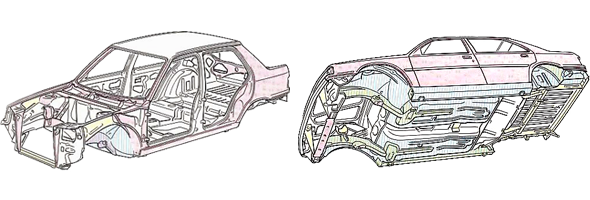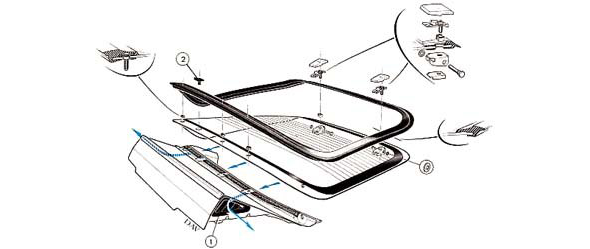Bodywork
Exterior measures (meters)


Structure
The Peugeot 309 body is a steel monobloc structure. It was computer-aided designed and all metal sheets thickness were thoroughly thought considering real-life constraints. A great weight loss was achieved thanks to the use of high yield steel sheets which enabled to use slender sheets.
Front and rear parts are composed of fusible zones, which absorb the energy when an impact occurs. The passenger cell will thus keep its shape. More, the tank, which is situated under the rear seats assures security from rear impacts.
Wrap around, reinforced bumpers absorb minor impacts without any distortion at low-speed. The rear bumper is equipped with a shock-absorber that allows the vehicle to face rear impacts at 2,5 miles an hour without any permanent bending.
Protection
In order to maintain maximum protection against rust, the most vulnerable parts were protected and specific arrangements were made. Body parts surrounding the wheels as well as parts underneath have specific shapes designed not to restraint mud and are made of anti-gravelling PVC.
Two types of metal sheets were used: electro-plated sheets and galvanized sheets. Wax fluid was injected into the body cavities after paintwork had been done.
Before the lacquer was applied by automatic spraying system, the whole carrossery received the following treatments:
- phosphatizing
- cataphoresis
- priming

Blue represents anti-gravelling PVC.
Yellow represents galvanized sheets
Red represents electro-plated sheets
Green represents specific shaped areas to restraint mud and water
Aerodynamism
The main objective was to maintain a drag coefficient as low as possible. Thanks to studies made by Peugeot ingeneers on the VERA+ prototype, it was possible to achieve good results, considering costs.
CX = 0,30 and S.CX 0,555 on GR Profile model.
CX = 0,33 and S.CX 0,615 on other models.
Aerodynamic studies were done on the following:
- front skirt and front panel shapes
- front panel sealing (GL Profil)
- doorways sealing (GL Profil)
- flat windshield joint
- profiled exterior rear-view mirror
- small but yet effective rear boot spoiler (GL Profil – SR – GT)
- minimized turbulences thanks to lower-end rear bumper (no mud projections to tailgate glass)
- plain wheel covers (GL Profil – GR – SR – GT)
- fairing under engine and rear floor (GL Profil)
- organized air flow.
Tailgate (mark I)
As you can see from the picture below, the rear window is specific to the Peugeot 309 MKI:
- The window is part of the tailgate and is fixed to the car body.
- The moving parts are directly screwed on the window.
- The rear body part is screwed with the window and it receives the two struts .
- A rubber seal joint and double-sided tape hold the glass and ensure with embedded studs the lower metal part setting on the glass.
- Metal spacers interposed in each of the mounting holes of the glass limit contacts with glass and metal.
- Two hinges fitted with a translation axis retained by a “Truarc” type ring allow removal of the tailgate without any necessary realignment of the whole.
Also note that the gills located at the base of the glass and on the metal part sides (1) ensure effective air extraction. In addition to that, it is possible to fit a rear wiper mechanism to models without this equipment (a rubber cap seals the wiper arm fixing (2)).


